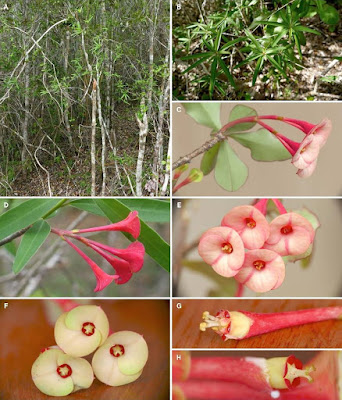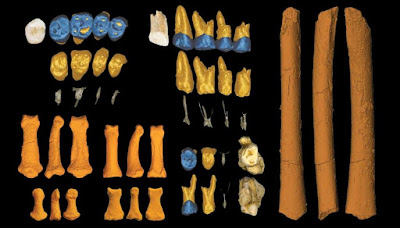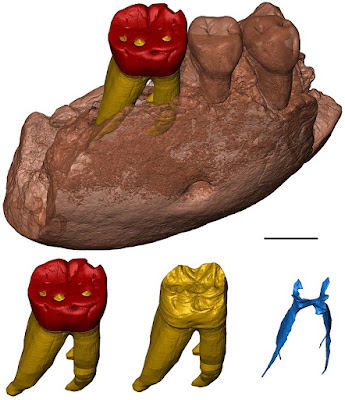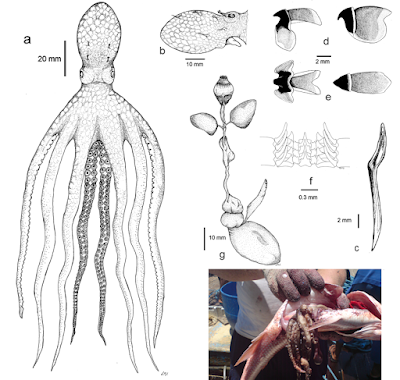[Most Recent Entries] [Calendar View]
Thursday, April 11th, 2019
| Time | Event | ||||||
| 2:03a | [Botany • 2018] Euphorbia longitubicinicyathium (Euphorbiaceae) • A New Species of Euphorbia sect. Goniostema from northeastern Madagascar
Euphorbia longitubicinicyathium J.-P. Castillon & J.-B. Castillon (Euphorbiaceae), a new species from northeastern Madagascar is described and illustrated with field photographs. The new species belongs to Euphorbia sect. Goniostema Baill. ex Boiss. and is morphologically related to non thorny species of the east coast of Madagascar (e.g. Euphorbia geroldii Rauh, Euphorbia robivelonae Rauh or Euphorbia thuarsiana Baill.) but differs by its larger dimensions, its habit and its long trumpet shaped cyathia. Keywords: Euphorbiaceae, Euphorbia, Euphorbia sect. Goniostema, Madagascar, Taxonomy, New species
Euphorbia longitubicinicyathium J.-P. Castillon & J.-B. Castillon, spec. nova Jean-Philippe Castillon and Jean-Bernard Castillon. 2018. Une nouvelle espèce menacée de Euphorbia sect. Goniostema (Euphorbiaceae) du nord de Madagascar [A New Species of Euphorbia sect. Goniostema (Euphorbiaceae) from northeastern Madagascar.]. Candollea. 73(2); 187–191. En français, résumés anglais et français. DOI: 10.15553/c2018v732a2 Résumé: Euphorbia longitubicinicyathium J.-P. Castillon & J.-B. Castillon (Euphorbiaceae), une nouvelle espèce du nord-est de Madagascar est décrite et illustrée par des photos de terrain. Cette nouvelle espèce, appartenant à Euphorbia sect. Goniostema Baill. ex Boiss., est proche morphologiquement des autres espèces dépourvues d'épines de la côte est de Madagascar (par exemple Euphorbia geroldii Rauh, Euphorbia robivelonae Rauh ou Euphorbia thuarsiana Baill.), mais s'en distingue aisément par sa plus grande taille, son port général et ses longues cyathes en forme de trompette. | ||||||
| 6:09a | [PaleoAnthropology • 2019] Homo luzonensis • A New Species of Homo from the Late Pleistocene of the Philippines
Abstract A hominin third metatarsal discovered in 2007 in Callao Cave (Northern Luzon, the Philippines) and dated to 67 thousand years ago provided the earliest direct evidence of a human presence in the Philippines. Analysis of this foot bone suggested that it belonged to the genus Homo, but to which species was unclear. Here we report the discovery of twelve additional hominin elements that represent at least three individuals that were found in the same stratigraphic layer of Callao Cave as the previously discovered metatarsal. These specimens display a combination of primitive and derived morphological features that is different from the combination of features found in other species in the genus Homo (including Homo floresiensis and Homo sapiens) and warrants their attribution to a new species, which we name Homo luzonensis. The presence of another and previously unknown hominin species east of the Wallace Line during the Late Pleistocene epoch underscores the importance of island Southeast Asia in the evolution of the genus Homo.
Order Primates Linnaeus, 1758 Suborder Anthropoidea Mivart, 1864 Superfamily Hominoidea Gray, 1825 Family Hominidae Gray, 1825 Tribe Hominini Gray, 1825 Genus Homo Linnaeus, 1758 Homo luzonensis sp. nov. Etymology. The species name is derived from the island of Luzon, where the specimens were discovered. Locality. The type locality is Callao Cave, in the Callao Limestone formation in the Peñablanca region of northern Luzon, the Philippines. Florent Détroit, Armand Salvador Mijares, Julien Corny, Guillaume Daver, Clément Zanolli, Eusebio Dizon, Emil Robles, Rainer Grün and Philip J. Piper. 2019. A New Species of Homo from the Late Pleistocene of the Philippines. Nature. 568; 181–186. DOI: 10.1038/s41586-019-1067-9 Previously unknown human species found in Asia raises questions about early hominin dispersals from Africa nature.com/articles/d41586-019-01019-7 UP researchers co-discover new human species in Luzon New species of early human found in the Philippines https://phys.org/news/2019-04-species-ea | ||||||
| 11:15a | [PaleoAnthropology • 2019] Evidence for Increased Hominid Diversity in the Early to Middle Pleistocene of Indonesia
Abstract Since the first discovery of Pithecanthropus (Homo) erectus by E. Dubois at Trinil in 1891, over 200 hominid dentognathic remains have been collected from the Early to Middle Pleistocene deposits of Java, Indonesia, forming the largest palaeoanthropological collection in South East Asia. Most of these fossils are currently attributed to H. erectus. However, because of the substantial morphological and metric variation in the Indonesian assemblage, some robust specimens, such as the partial mandibles Sangiran 5 and Sangiran 6a, were formerly variably allocated to other taxa (Meganthropus palaeojavanicus, Pithecanthropus dubius, Pongo sp.). To resolve the taxonomic uncertainty surrounding these and other contentious Indonesian hominid specimens, we used occlusal fingerprint analysis (OFA) to reconstruct their chewing kinematics; we also used various morphometric approaches based on microtomography to examine the internal dental structures. Our results confirm the presence of Meganthropus as a Pleistocene Indonesian hominid distinct from Pongo, Gigantopithecus and Homo, and further reveal that Dubois’s H. erectus paratype molars from 1891 are not hominin (human lineage), but instead are more likely to belong to Meganthropus. Clément Zanolli, Ottmar Kullmer, Jay Kelley, Anne-Marie Bacon, Fabrice Demeter, Jean Dumoncel, Luca Fiorenza, Frederick E. Grine, Jean-Jacques Hublin, Anh Tuan Nguyen, Thi Mai Huong Nguyen, Lei Pan, Burkhard Schillinger, Friedemann Schrenk, Matthew M. Skinner, Xueping Ji and Roberto Macchiarelli. 2019. Evidence for Increased Hominid Diversity in the Early to Middle Pleistocene of Indonesia. Nature Ecology & Evolution. DOI: 10.1038/s41559-019-0860-z Reassessing the Early to Middle Pleistocene hominid diversity in Java | ||||||
| 4:25p | [Cephalopoda • 2019] Lepidoctopus joaquini • A New Genus and Species of Octopus; Surveying Cephalopod Diversity of the Amazon Reef System using Samples from Red Snapper Stomachs Abstract The cephalopod fauna of the southwestern Atlantic is especially poorly-known because sampling is mostly limited to commercial net-fishing operations that are relatively inefficient at obtaining cephalopods associated with complex benthic substrates. Cephalopods have been identified in the diets of many large marine species but, as few hard structures survive digestion in most cases, the identification of ingested specimens to species level is often impossible. Samples can be identified by molecular techniques like barcoding and for cephalopods, mitochondrial 16S and COI genes have proven to be useful diagnostic markers for this purpose. The Amazon River estuary and continental shelf are known to encompass a range of different substrates with recent mapping highlighting the existence of an extensive reef system, a type of habitat known to support cephalopod diversity. The present study identified samples of the cephalopod fauna of this region obtained from the stomachs of red snappers, Lutjanus purpureus, a large, commercially-important fish harvested by fisheries using traps and hook-and-line gear that are capable of sampling habitats inaccessible to nets. A total of 98 samples were identified using molecular tools, revealing the presence of three squid species and eight MOTUs within the Octopodidae, representing five major clades. These include four known genera, Macrotritopus, Octopus, Scaeurgus and Amphioctopus, and one basal group distinct from all known octopodid genera described here as Lepidoctopus joaquini Haimovici and Sales, new genus and species. Molecular analysis of large predatory fish stomach contents was found to be an incredibly effective extended sampling method for biodiversity surveys where direct sampling is very difficult. Family Octopodidae d’Orbigny, 1840 Subfamily Octopodinae d’Orbigny, 1840 Lepidoctopus joaquini Haimovici and Sales, gen. et sp. nov. Diagnosis of the genera and species: small sized benthic octopod, largest examined specimen 40 mm mantle length (ML); mantle, head and base of arms covered by large rounded papillae-like dermal cushions more densely packed and larger on dorsal mantle and smaller on head and web; some papillae on dorsal mantle bear cirri branched in multiple tips; no lateral ridge observed; eyes moderate in size, slightly protruding and with single supraocular papillae with large branched cirrus, funnel half of ML; arms long, first and second typically around 4.5 times ML, third and fourth under 4.0 times ML; web typically half of ML; normal arms with up to 170 suckers, first 4 to 6 proximal suckers in single series, followed biserial to tips of arms; enlarged suckers in fourth to sixth biserial rows of males; third left arm of males hectocotylized, ~77% of the opposite third arm with 68 to 72 suckers, Short hectocotylus, ~22% of hectocotylized arm, with short conical calamus, 2% of ligula length, slender ligula with deep longitudinal groove ending in blunt tip. .... Etymology: The genus name is a combination of lepido from scale in Greek, referring to the scaly appearance given by the large almost overlapping papillae (dermal cushions) on its skin giving it a peculiar appearance as if it is covered with scales, and octopus. The name joaquini refers to the young son of the first author of this paper (João Bráullio de Luna Sales).  João Bráullio de Luna Sales, Manuel Haimovici, Jonathan Stuart Ready, Rosália Furtado Souza, Yrlene Ferreira, Jessica de Cassia Silva Pinon, Luis Fernando Carvalho Costa, Nils Edvin Asp, Iracilda Sampaio and Horacio Schneider. 2019. Surveying Cephalopod Diversity of the Amazon Reef System using Samples from Red Snapper Stomachs and Description of A New Genus and Species of Octopus. Scientific Reports. volume 9, 5956. DOI: 10.1038/s41598-019-42464-8 |
| << Previous Day |
2019/04/11 [Calendar] |
Next Day >> |
















